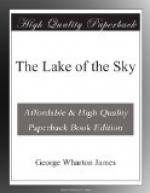[Illustration: Gilmore Lake, Pyramid Peak and the Crystal Range, in winter, from summit of Mount Tallac]
[Illustration: Desolation Valley, Looking Toward Mosquito Pass]
[Illustration: Heather Lake, near Glen Alpine]
[Illustration: Susie Lake, near Glen Alpine Springs]
Let us, if possible, stand and watch the Master Workman doing the work that is to make this region our source of present day joy. We will make the ascent and stand on the summit of Pyramid Peak. This is now 10,020 feet above sea level, rising almost sheer above Desolation Valley immediately at our feet.
The first thing that arrests the visitor’s attention is the peculiar shape of the peak upon which he stands, and of the whole of the Crystal Range. Both east and west it is a great precipice, with a razor-like edge, which seems to have been especially designed for the purpose of arresting the clouds and snow blown over the mountain, ranges of the High Sierras, and preventing their contents falling upon the waste and thirsty, almost desert-areas of western Nevada, which lie a few miles further east.
Whence do the rains and snow-storms come?
One hundred and fifty miles, a trifle more or less, to the westward is the vast bosom of the Pacific Ocean. Its warm current is constantly kissed by the fervid sun and its water allured, in the shape of mist and fog, to ascend into the heavens above. Here it is gently wafted by the steady ocean breezes over the land to the east. In the summer the wind currents now and again swing the clouds thus formed northward, and Oregon and Washington receive rain from the operation of the sun upon the Pacific Ocean of the south. In June and July, however, the Tahoe region sees occasional rains which clear the atmosphere, freshen the flowers and trees, and give an added charm to everything. But in the fall and winter the winds send the clouds more directly eastward, and in crossing the Sierran summits the mist and fog become colder and colder, until, when the clouds are arrested by the stern barriers of the Crystal Range, and necessity compels them to discharge their burden, they scatter snow so profusely that one who sees this region only in the summer has no conception of its winter appearance. The snow does not fall as in ordinary storms, but, in these altitudes, the very heavens seem to press down, ladened with snow, and it falls in sheets to a depth of five, ten, twenty, thirty and even more feet, on the level.
Look now, however, at the western edge of the Crystal Range. It has no “slopes.” It is composed of a series of absolute precipices, on the edge of one of which we stand. These precipices, and the razor edge, are fortified and buttressed by arms which reach out westward and form rude crescents, called by the French geologists cirques, for here the snow lodges, and is packed to great density and solidity with all the force, fervor and fury of the mountain winds.




